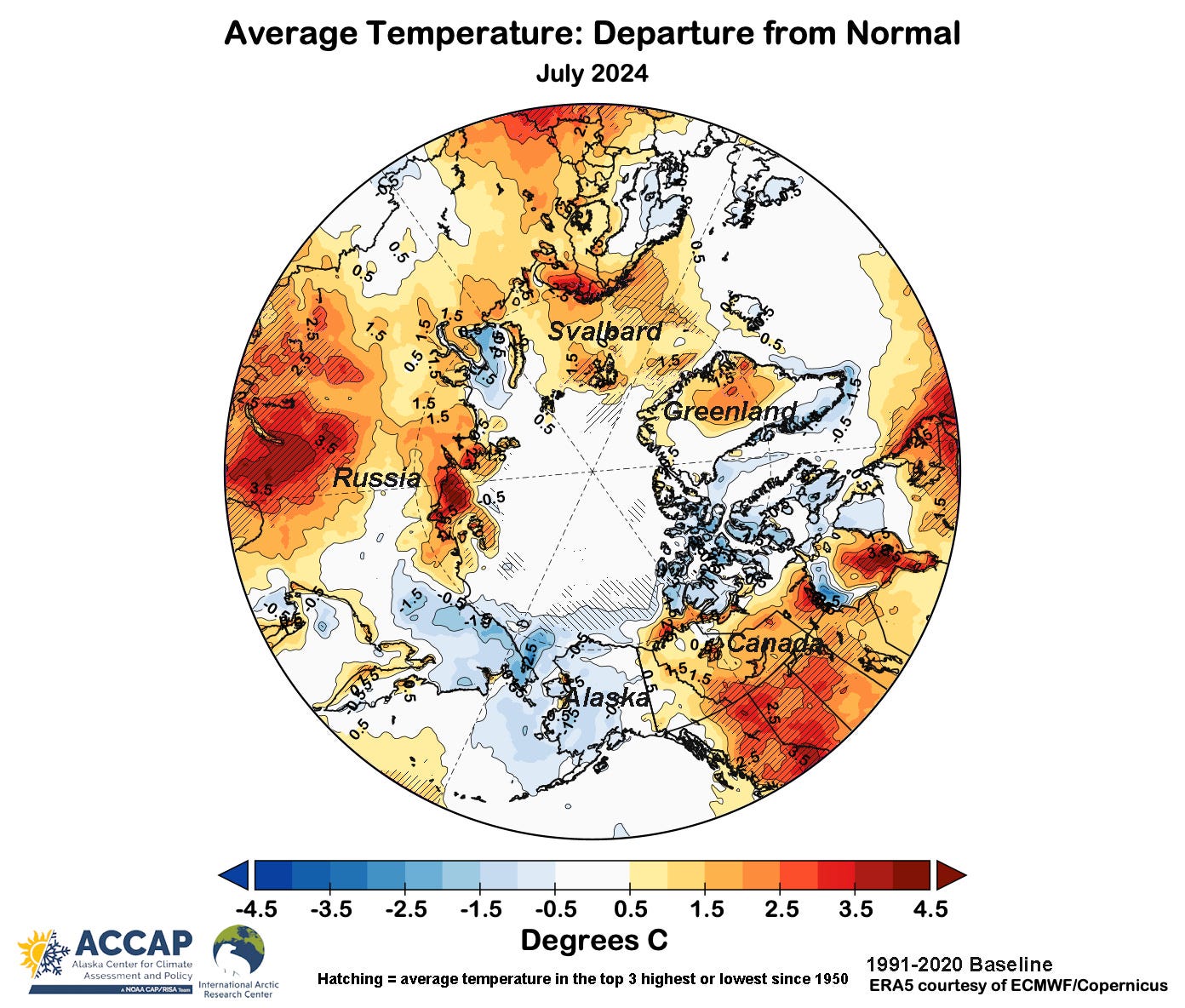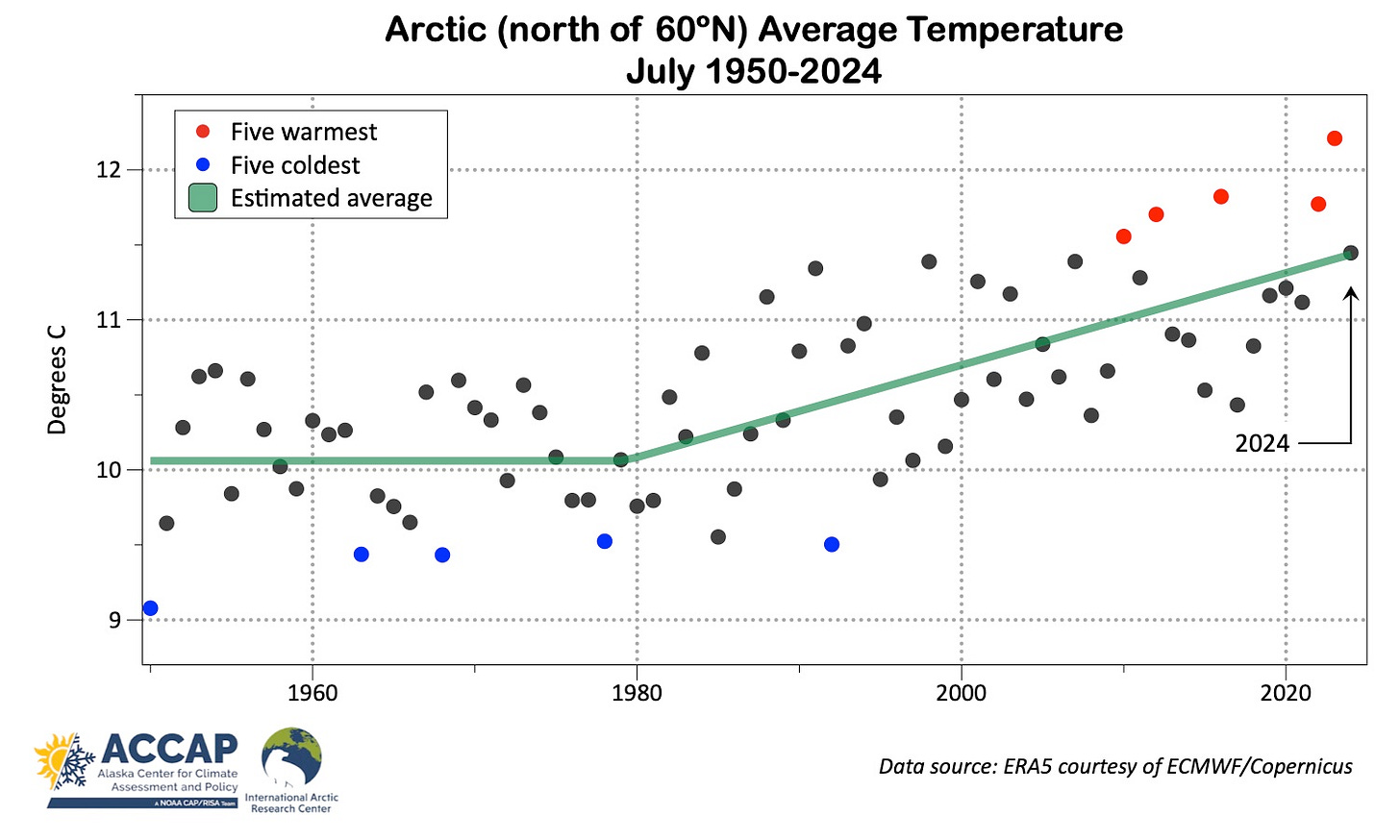For the July 2024 recap of sea ice, wildfire and melt on the Greenland ice sheet see my post here.
Arctic
July temperatures overall were pretty typical for recent years but with a lot of regional variability. Figure 1 shows temperature departures from the 1991-2020 average based on the ERA5 reanalysis. Much of Canada’s Northwest Territories and western Nunavut were very warm, and the warmth over north-central Siberia, while not as extreme as in June, kept wildfires going. In contrast, the Russian far northeast, western and central Alaska and most of the Canadian Arctic Island were cooler than the 1991-2020 average.

For the Arctic as a whole (land and oceans poleward of 60°N), this July was not quite as warm as the past two years but was this was the seventh warmest July since 1950, and reflecting how fast the Arctic is warming, this July was warmer than any July was prior to 2010. For land areas north of 60°N this was the sixth warmest July.

July total precipitation trends in the Arctic have dramatic spatial variability, with large increases over parts of Alaska and northern Canada but significant decreases over parts of Siberia and much of Greenland north toward the North Pole. Overall, between 1974 and 2023 the Arctic-wide July precipitation increased about four percent.
This July (Fig. 2), precipitation (rain plus the liquid equivalent of snow) was very high over parts of northern Arctic Canada, Greenland, the Nordic Arctic and Alaska. In contrast, much of the Russian Arctic except for the far northeast had below normal totals.

The regional extreme largely balanced out, with the Arctic-wide average July total precipitation just three percent above the 1991-2020 average.
Alaska
July temperature departures from normal around Alaska (Fig. 4) were dramatically different from June (see Fig. 4 here). Nearly 87 percent of Alaska was at least slightly cooler than normal in July and some places in west and southwest Alaska had the coolest July in more than a decade. From the reliable weather and climate stations, the highest temperature in July was 91F (32.8C) July 23 at the Ester 5NE cooperative station in the Goldstream valley just north of Fairbanks, while the lowest temperature was 29F (-1.8C) on July 8 at the NOAA climate reference network station northeast of Utqiaġvik. The sharp heatwave July 21 to 25 was quite notable. Some places in western and southwest Alaska saw the highest temperatures since the hot summer of 2019, and McGrath’s high of 90F (32.2C) was a new all-time July record, nipping the previous record of 89F( 31.7C) set most recently in July 2019.

Rainfall in July was well above normal in much of Alaska (Fig. 5), and the ERA5 average for the entire state was higher than any July in the past 75 years. Not everywhere was wet though. Kodiak, with just two inches of rainfall for the month, had the driest July since 2013, and the upper Tanana valley and southern Southeast also had less rain than usual.

On the high end, some site-specific July totals included:
Juneau Airport: 12.21 inches, highest July precipitation on record (since 1943)
Bethel: 4.39 inches, highest July precipitation since 1928
Nome: 6.16 inches, fifth highest July precipitation (since 1906)
Anchorage Airport: 4.03 inches, seventh highest total, and 3 of the 7 highest July precipitation totals have been the past three years. Additionally, 1.93 inches rain July 13-14 was the highest 24 hour total in July since 2001
Fairbanks: 4.18 inches, seventh highest July precipitation and highest summer-month total since August 2019
Cordova Airport: 10.41 inches, highest July precipitation since 1981
Sea surface temperatures in the Gulf of Alaska during July (Fig. 6) were quite close to the 1991-2020 average, but it was a different story farther west and north. The eastern Bering Sea and nearly all of the Chukchi and Alaska portion of the Beaufort Sea saw cooler than normal waters in July.

The northern Bering Sea east of the dateline had the lowest average sea surface temperature for July since 2011, and this was likely attributable to higher than usual storminess. North of the Bering Strait, slow melting sea ice was a contributor to the cool ocean temperatures, with the eastern Chukchi Sea having the lowest July average sea surface temperatures since 2006.




Very useful information, even as we are looking-at an August heat anomaly coming to the high Canadian Arctic. Time to buy real estate on Baffin Island while prices are still cheap.